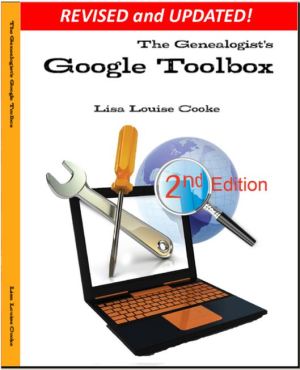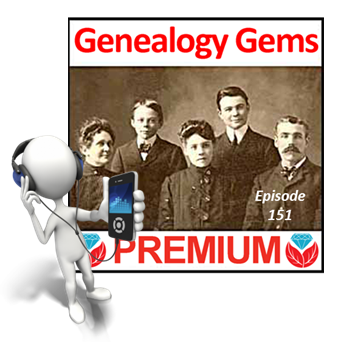How to Use Google Image Search to Identify Old Photos on Smartphones and Tablets – Free Video
How to use Google image search to identify old photos, that’s what we are covering today! These tech-tip videos are my way of sharing tips and tricks that will save you time and add to your genealogy and family history research success. You don’t have to love genealogy to put these tips into action! So join me as I share a little tech-tip on how to use Google image search to identify old photos on smartphone and tablets.

My new tech-tip video posted to the Genealogy Gems YouTube channel is all about how to use Google image search to identify old photos. You may remember, I posted a similar video on how to upload an image to Google on your laptop or home computer, run a search to find other images that match, and most importantly, identify that image. After watching that video, Doris wrote me the following email:
“I just enjoyed your video about Google Images. It seems that it won’t work on my iPhone 6S +. I have to wait until I am on my laptop, later. What a great tip! Thanks for all you do to help us make our computer life easier and more fun.”
Well Doris, you don’t have to wait to get back home to do a Google image search! This video will show you, step-by-step, how to search for images right from your mobile device.
After watching this helpful video, Amie, our Content Creator here at Genealogy Gems, shared with me this tidbit:
“Lisa, I just wanted to share what I did after watching your video, “How to Google Search Images – Smartphone and Tablets.” When I had a little wait time, I went into my FamilySearch app on my phone and found the pictures I had saved to my FamilySearch Tree. Then, using your instructions, I looked to see if any of those ancestor photos were found anywhere else on the web. Guess what? I made a cousin connection with one of the photos. I found a cousin had put Great-Grandpa’s picture on her Pinterest page! Just another genealogy success story!”
And there you have it! By learning a few tips, you can use your smartphone or tablet for searching Google images just like Doris and Amie. A follow-up email from Doris after watching this video just made my day:
“I watched this video yesterday while I was riding in the car. What a fun surprise! I tried it and it worked! Thanks for doing this for me. I am grinning right now just thinking about it.”
You are so welcome, Doris. I hope that others will give it a try, too.
Thanks for watching and reading, friends…and keep the comments and emails coming. I love to hear from you!
Learn More About Google Image Search and Everything Google for Genealogy

Ready to learn more about how to use Google for genealogy and mining it for your own genealogical treasures? The Genealogist’s Google Toolbox, is your go-to resource! It’s available now both in print and e-book format. In its chapters–fully revised and updated –you’ll learn more about all these Google tools and more. Better yet, after you learn how to use these tools for family history research, you’ll find yourself using them to find all kinds of things, from recipes to trivia, to a manual for your old car.
When to Use Google Translate for Genealogy–And Best Translation Websites for When You Don’t

Thanks to Katherine Schober of SK Translations for this guest blog post.
Google Translate for Genealogy–and its Limits
Google Translate is a good tool for translating individual words and short, non-complex sentences. But it works better with basic words rather than long sentences or paragraphs. This tool often ignores idioms, or words and phrases that mean something different than the actual words imply.
Mistranslations of idioms can completely change the meaning of a document and leave you confused about certain aspects of your ancestor’s life.
In German, for example, there are multiple idioms using the word “sausage,” a food that is a large part of the culture in Germany. If you type in the German idiom “Jemandem eine Extrawurst braten,” which literally means “to fry someone an extra sausage,” Google translates it word for word, coming up with the translation result “to bake an extra sausage.” This may leave the non-experienced person confused, thinking their ancestor was discussing cooking a meal. However, an experienced translator would know that this phrase actually means “to give someone special treatment,” and has nothing to do with cooking. (See my blog post, “10 Hilarious German Sausage Sayings to Try on Your Friends.”)
Google Translate can also be unreliable if a word has multiple meanings. For example, think of the word “run” in English. It can mean “a fast jog,” “a tear in your stocking,” “to be a candidate for an election,” and so on. Google Translate could easily pick the wrong English translation of your of your word, leaving you with a falsely translated document or simply very confused.
Beyond Google Translate: Best Translation Websites
Here are three websites I recommend when Google Translate just isn’t up to your genealogy translation needs:
- Linguee.com: This is a very helpful translation site. Unlike Google Translate, it shows you words and phrases translated into English by actual translators and not machines. You receive the definition of the word, plus pages of various sample sentences that include your word/phrase in a contextual format (in both the foreign language and in English). This means you can scroll through the examples to see which translation is the most accurate English word for your document.
- WordReference.com: This is an online dictionary with multiple language options available. Depending on the word, it may provide sentence examples and other entries where your word is found. This helps you to ensure the translated word is the right option for your text.
- Google.com: Although Google Translate can’t always get the meaning right, the Google.com search engine is a wonderful reference. If you can’t find your foreign word on the sites above, try typing it into a Google search with the word English after it. Sometimes you will find forums where your word is discussed by various family historians. If this doesn’t work, try adding genealogy after English, or taking English out and just writing genealogy. Playing around with your search request may very well give you different results. And Lisa Louise Cooke recommends putting quotation marks around the word in order to ensure it appears in every search result. Here’s an example of how that search would look: “Geburt” English Genealogy
 I’ve previously recommended top websites especially for German translations on this blog: click here to check it out. Good luck to Sue, who commented after reading that post: “Great article! I can’t wait to try some of these websites. We have a large stack of German letters written to my husband’s mother that look impossible to read. Thank you!”
I’ve previously recommended top websites especially for German translations on this blog: click here to check it out. Good luck to Sue, who commented after reading that post: “Great article! I can’t wait to try some of these websites. We have a large stack of German letters written to my husband’s mother that look impossible to read. Thank you!”
Katherine Schober of SK Translations specializes in translating German genealogical and historical documents. She has recently joined Lisa Louise Cooke on the Genealogy Gems Premium Podcast: catch her creative, use-in-any-language translation tips in episodes #151 and #152. Not a Premium member yet? Click here to see what you’re missing out on in the Genealogy Gems Premium Podcast: Premium members get a year’s worth of access to all episodes! (Time for a binge-listening weekend??) And if you’d like to learn how to learn how to read the old German handwriting check out her online course here.





